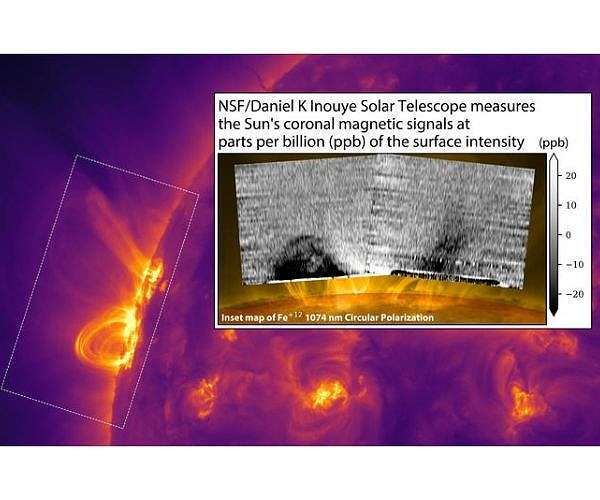17.09.2024

The NSF Daniel K. Inouye Solar Telescope presents its first map of the solar coronal magnetic field signals as measured using the Zeeman Effect. The Zeeman Effect polarizes the coronal emission, which requires the advancements of the Inouye Solar Telescope to measure as its signals are only a few parts per billion of the Sun's surface brightness. The background image identifies the region observed in detail by Inouye as imaged by NASA�s Solar Dynamics Observatory in ultraviolet light.
The U.S. National Science Foundation's (NSF) Daniel K. Inouye Solar Telescope, operated by the NSF's National Solar Observatory (NSO), has successfully mapped the magnetic fields in the solar corona for the first time. The solar corona, visible during a total solar eclipse, is the outermost layer of the Sun's atmosphere. This achievement is expected to significantly improve our ability to understand space weather and its effects on technology here on Earth.
The Sun's magnetic field drives the formation of energy-rich regions in the atmosphere, often linked to sunspots, which in turn fuel solar storms that shape space weather. The corona is where these processes occur. Mapping the magnetic fields in this region is crucial for predicting space weather, which is essential to protect our technology, both on Earth and in space.
The Earth's magnetic field shields us from solar winds, helping to protect our atmosphere. However, major solar events, such as eruptions, can still disrupt satellites, power grids, and communication systems. Studying the magnetic fields in the corona is key to forecasting these events and mitigating their impact on our increasingly technology-dependent society.
For decades, measuring the magnetic properties of the corona has been one of the most difficult challenges in solar physics. With its advanced capabilities, the Inouye Solar Telescope has made a significant step toward solving this issue by generating its first detailed maps of the corona's magnetic fields.
Inouye's Contribution to Solar Physics
While solar physicists have been mapping the Sun's magnetic fields on its surface since the 1950s, the fields in the corona have remained largely unexplored. It is in these outer regions of the Sun's atmosphere that solar storms are born. Now, thanks to the Inouye, located atop Haleakala in Maui, Hawai'i, scientists can finally begin to fill this critical gap in knowledge.
The telescope has successfully mapped the magnetic fields of the solar corona using the Zeeman Effect, a technique that detects magnetic properties by observing how the Sun's light interacts with magnetic fields. The Inouye's capabilities surpass previous attempts at mapping these fields, which had been limited by a lack of detail. The last significant effort to observe the corona's magnetic fields occurred two decades ago (Lin et al. 2004), but today, Inouye's advanced technology offers regular and detailed observations of these important signals.
The Sun's corona is a million times fainter than the solar disk and can typically only be seen during a total solar eclipse. The Inouye Solar Telescope, however, uses a technique called coronagraphy to simulate an eclipse, allowing it to observe the faint polarized signals from the corona without waiting for an actual eclipse. This technique enables scientists to study signals that are a billion times fainter than the solar disk.
One of the key instruments used for this research is the Cryogenic Near-Infrared Spectropolarimeter (Cryo-NIRSP), designed by the University of Hawai'i Institute for Astronomy. This instrument allows the telescope to map the magnetic fields of the corona with unprecedented precision.
"The Inouye's achievement in mapping the Sun's coronal magnetic fields is a testament to the innovative design and capabilities of this trailblazing unique observatory," said Tom Schad, a scientist at the NSO and the lead author of the study. "This breakthrough promises to significantly enhance our understanding of the solar atmosphere and its influence on our solar system."
Looking Ahead
The Inouye's first maps of the solar corona's magnetic fields mark a significant milestone in solar research. As more detailed maps are produced, scientists will be able to better understand and predict solar storms and their effects on space weather.
"Just as detailed maps of the Earth's surface and atmosphere have enabled more accurate weather prediction, this thrillingly complete map of the magnetic fields in the sun's corona will help us better predict solar storms and space weather," said Dr. Carrie Black, NSF program director for the NSO. "The invisible yet phenomenally powerful forces captured in this map will propel solar physics through the next century and beyond."
Christoph Keller, NSO Director, emphasized the broader significance of this discovery: "Mapping the strength of the magnetic field in the corona is a fundamental scientific breakthrough, not just for solar research, but for astronomy in general. This is the beginning of a new era where we will understand how the magnetic fields of stars affect planets, here in our own solar system and in the thousands of exoplanetary systems that we now know about."
Ongoing and future research will focus on refining the tools and techniques used to map the Sun's magnetic environment, leading to further discoveries about the impact of space weather on Earth and beyond.
Quelle: SD
